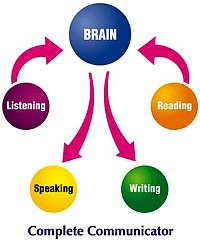 |
Learn English Locally, Apply It Worldwide! Enjoy Regular Practice |
Dividing Messages into Tone Units
Last time I planned for us to step further, to work on dividing a message into tone units. This is done easier in speech than in writing, since oral communication is more variable in its structuring of information than the written communication.
This lesson will be easier for our Chinese students to assimilate than any other people in the world, since the tones we are going to use here are the rising tone (á), falling tone (à) and the falling-rising tone (ǎ) typically used in Chinese. Good for you, my friends, and if your language does not distinguish between these tones, well... I'm afraid you're just going to have to work hard on understanding this aspect. Without further ado, let us start this lesson:
1) A single sentence may have only one tone unit, as in:
¦“My
friend has a cat and two ràbbits.”¦
- if you remember, from the lesson on pieces of information.
2) However, when the sentence is larger than, say ten words, the listener would be more comfortable if the message would come in a number of separate pieces of information:
- ¦“The zoo keeper told us about the mὸnkeys.”¦
- ¦“The zoo keeper tŏld us about the monkeys¦who wanted to bite his friènd.”¦
- ¦ “The zoo keeper tŏld us about the monkeys¦who wanted to bite his friĕnd ¦when she gave them the fὸod.” ¦
Cutting up speech into tone units depends on such things as
- - the speed at which you are speaking;
- - what emphasis you want to give to parts of the message; and
- - the length of the grammatical units.
How do we know how to split our sentences into tone units?
Usually we use a single tone unit for each sentence, meaning each sentence ends with a downward tone:
¦“I’d like some àpples.”¦
There are a few exceptions and this is when you have different tones:
i) When a sentence starts with an adverbial phrase, this one gets a separate tone unit:
¦“Before he moved to Chína,¦my friend travelled around the wὸrld.”¦
ii) If there is an explanation within the sentence (a non-restrictive postmodifier, like a relative clause) we would give this a separate tone unit as well:
¦“The prettiest girl in the whole cláss,¦the one wearing a blue dress todǎy, is my brother’s gìrlfriend.”¦
iii) If we have a clause in the middle of a sentence, we mark it separately:
¦“And this is whý,¦as a result of the argument with his bóss,¦he quit his job in the ènd.”¦
iv) A vocative (when you call somebody) has its own tone unit:
¦“Ădam,¦ what are you dóing?”¦
v) The same applies to a linking adverb (however, altogether, in contrast)
¦“The teàcher ¦ howéver,¦wasn’t convinced that all the students understood the màtter.”¦
vi) When you have a clause or a long noun phrase acting as a subject, you also need to give it a separate tone unit:
¦“What he wǎnted ¦was a bit of èmpathy.”¦
vii) When two or more clauses are linked by coordination, each has a separate tone unit:
¦“The wizard took his wand out of his pockét ¦and cast a spell onto ùs.” ¦
Well, this is pretty much how this matter works. Once you understand it, I recommend you should build your own sentences following the examples here – make at least 5-10, to get the feel of the intonation in your sentences. After that, you’ll understand punctuation much better.
English Corner Weekly E-zine
Packed with knowledge, published on Tuesdays.
Get yours here!
Our Archives:
Our lessons in the names and sounds of letters, short & long vowel sounds, CVCs, CCVCs, CVCCs, sight words, vowel and consonant contrasts, etc.
Our lessons will help increase your vocabulary, word recognition, find meaning in context, skills for TOEFL tests and other games, for fun.
Here we shall build some lessons to help you improve your writing skills.
Lots of lessons: cause & effect, comparisons, linking signals, relative clauses, presenting information, expressing emotions and grammar games, of course. We had more lessons on: intensifying adverbs and phrasal verbs, expressing various concepts such as addition, exception, restriction and ambiguity. Lately we started some exercises: likes/dislikes, frequency adverbs (twice), verb tenses, etc.
Learn how to build a website, by using the SBI! system - start from the basics, developing a site concept and a niche, supply and demand, learn about profitability and monetization, payment processing, register domain, website structure and content as a pyramid. Also learn about the tools I'm using to build this website. We also covered how to build traffic, working with search engines, building a good system of inbound links, using social marketing and blogs with the SBI system, how to use Socialize It and Form Build It, how to publish an e-zine and how to build a social network in your niche.
We looked at a few games by now: Countable & uncountable nouns, Free Rice, Name That Thing, Spell It, Spelloween, the Phrasal Verbs Game, Preposition Desert, The Sentence Game, Word Confusion, Word Wangling, Buzzing Bees, and The Verb Viper Game.
Be prepared to play and learn more pretty soon.
